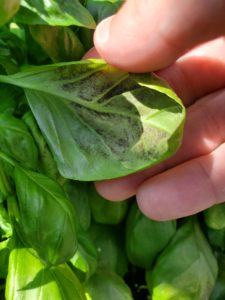Basil downy mildew has been confirmed in potted sweet basil being sold by a box-store in Cumberland County in southern New Jersey. This is the second report of BDM in the state and region this growing season. All basil growers are encouraged to scout their fields or greenhouses on a daily basis and should consider initiating a preventative fungicide program. [Read more…]
Basil downy mildew confirmed in southern New Jersey – ALERT 6/2/21
Basil downy mildew has been confirmed in a home owners garden in Atlantic County in southern New Jersey. This is the first report of BDM in the state and region this growing season and about three weeks earlier than last year. All basil growers are encouraged to scout their fields or greenhouses on a daily basis. [Read more…]
Controlling basil downy mildew in the field
For over a decade, basil downy mildew (BDM) has caused significant losses in basil grown in organic and conventional field and greenhouse production across the United States. At the time of its introduction, there were very few fungicides labeled for its control making it nearly impossible to grow a successful crop in many areas of the country. [Read more…]
Sweet Basil Virtual Workshop This Thursday and Friday

Sweet basil infected with basil downy mildew.
Managing Basil Under Increasingly Challenging Conditions, a virtual workshop, will be held this Thursday, Dec. 10, and Friday, Dec. 11. Hosted by University of Massachusetts in collaboration with Rutgers, The State University of New Jersey and the University of Florida as part of our USDA/SCRI/NIFA supported Sweet Basil Research Initiative, with Drs. Jim Simon and Andy Wyenandt of Rutgers co-coordinating the educational program for growers, Extension workers, researchers and industry reps.
The virtual sessions will be on the Zoom platform. Links and other means of connecting will be shared in another post before the meeting begins after you register here <https://forms.gle/iofJ79idzyG3j48ZA>.
Click here to view the updated agenda. All meeting times are Eastern Standard Time running 9:00am to 5:15pm on Dec. 10, and 9:00am to 12:30pm on Dec. 11. Feel free to join in or leave at any time to learn about the topics that interest you.
Basil downy mildew confirmed in southern New Jersey – ALERT 6/30/20
Basil downy mildew has been confirmed in field-grown basil and sweet basil being sold in ‘box store’ retail establishments in southern New Jersey. All basil growers are encouraged to scout their fields on a daily basis and begin preventative fungicide programs in BDM-susceptible and DMR varieties.
For more information on controlling BDM in the field-grown basil please click here.
For more information on controlling BDM in the greenhouse please click here.
To track the progress of BDM in the US please click here.

Basil downy mildew sporulating on the underside of an infected leaf.
Wine Grape Downy Mildew Update
By Peter Oudemans
June 4-6 and June 12 showed some significant downy mildew infection periods and we are now beginning to see the effects. Since berries are susceptible until about a month after capfall this is something we need to be concerned about. The question is how to handle this now?
Rules:
- Hitting the target: Make sure the sprayer is set up to hit the target.
- Longevity: Fungicides work best if they can dry after application. Rainfall before drying will wash them off
- Resistance: Downy Mildew is a high risk pathogen and fungicides must be rotated
